For some reason Manhattan’s east side has always had more north-south avenues than the west. Between 3rd and Park (4th Avenue) comes Lexington Avenue and between Park and 5th Avenue comes Madison Avenue. Lexington Avenue was conceived and partially constructed by developer Samuel Ruggles, who also built Gramercy Park, in 1832. Lexington Avenue proceeded north from the Park and was named for the revolutionary War’s Battle of Lexington. Madison Avenue, proceeding north from Madison Square, was also devised by Ruggles and was begun in 1836. There are no comparable “intermediary” avenues on the West Side, and the space between 5th and 6th Avenues is the widest in Manhattan. And, busy 34th Street even has a midblock stoplight to let Macy’s shoppers cross in safety between 6th and 7th Avenues.
In February I ventured forth from FNY Headquarters in Little Neck as the cabin fever was gradually producing madness, and marched from the 77th Street IRT #6 stop on Lex north to 92nd, where I walked over to 5th Avenue and got the M4 bus back to Penn Station. It was a compact 2-hour trip. While 92nd Street will wait for another day, here’s what I saw on Lex. It truns out there are a number of landmarked buildings on East 79th/80th just west of Lex, so I’ll have to go back for a look.

For some reason the section of Manhattan from about Lexington to the East River from 72nd north to 92nd is not covered by the AIA Guide to NYC, which is my default guidebook, so I’ll just have to employ some nonexpert opinion, e.g., my own. I liked this two-story lengthy building with decorative urns that takes up most of the west side of the block between West 78th and 79th.

Someday, someone will compile a list of all apartment names in NYC. Maybe it will be me. At #1125 I was drawn to the chiseled “St. George.” above the entrance, with the Period of Importance that was usually bestowed after titles or even mastheads up until the early 20th Century. The New York Times kept its Period of Importance until the early 1960s. 1125 is a 7 story apartment building with a circular corner, which we will see more of on Lex.

The high-steepled Unitarian Church of All Souls, with a spacious courtyard and piquant artwork, sits at the southeast corner of Lex and East 80th. It was designed by Hobart Upjohn (1876–1949) and built in 1932. Hobart was the grandson of British-born architect Richard Upjohn, best known in NYC for the Church of the Ascension on Lower 5th Avenue (1841) Trinity Church (1846) and the now-disassembled St. Saviour’s Church in Maspeth, Queens (1847). Hobart Upjohn’s practice designed many ecclesiastical and educational buildings in New York State and also North Carolina.
This was the first Unitarian Universalist church in the United States. In brief, Unitarians reject the concept of the holy trinity as well as original sin, while Universalists rejected the Puritanical notion that a select few will be saved and believe in reconciliation for all.
133 East 80th Street, catercorner to the church, is an early high-rise residential building, designed by Rosario Candela in 1929. To comply with the relatively recent zoning laws adopted in 1916 to avoid throwing too much shadow on the street, 133 is set back on its upper stories. Deco-ish gargoyles guard the upper tower while differently designed ones overlook the sidewalk. The roof structure cleverly conceals a roof water tank.

What is enshrouded at the southeast corner of Lex and East 82nd? The venerable drugstore Lascoff’s, founded in 1899 – old enough to once vend leeches. The venerable signboard, in place since 1931, is still affixed to the wall. You would hope that whatever is replacing the drugstore, which closed in July 2012, will keep the signboard and add new lettering for whatever business occupies the storefront.
Lascoff, along with Bigelow and one or two others, was one of New York’s great, classic pharmacies. It opened in 1899, when McKinley was President, and was the first licensed pharmacy in New York State, according to the New York Times. It was a store so majestic and solemn, you felt like you were entering a church when you went in. High ceilings, high shelving, a balcony, ancient Pharmacuetical relics, and silence. No music. You could find many old and classic brands there that you couldn’t locate elsewhere. And the vertical sign on the corner building was one of the grandest in the city. Lost City

Fortunately, for fans of old signage and candy stores, the Lexington Candy Shop a block north on East 83rd and Lex is still there.
The venerable apartment building across East 82nd from Lascoff’s, which may predate the drugstore, has recently been given a green paint job. The ornate arch and pilastered entrance features a goddess overlooking the doorway.
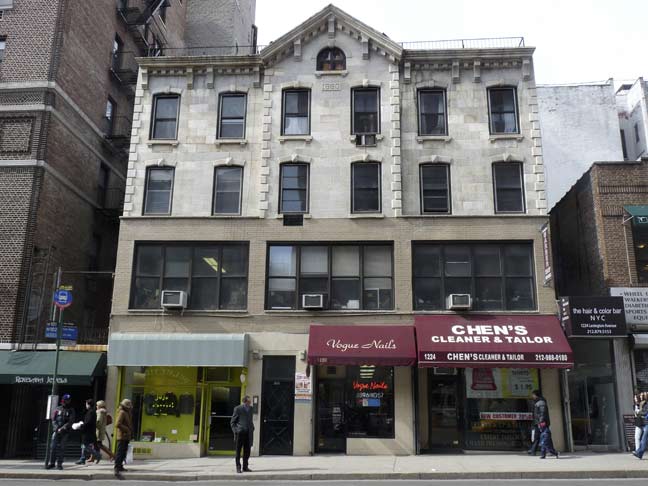
This castle-like building, west side of Lex between 82nd and 83rd, goes back to 1880. Until the early 20th Century, builders were helpful enough to include the date of construction on many buildings. Since the center bays out a little, the building has 4 sets of quoins. Likely one of the older survivors in the area and probably the first building on the site.

One of the more inept sign painting jobs I’ve seen in NYC, but I’m glad to see the art hasn’t yet died out. On West 83rd facing Lexington.

On the northwest corner of West 83rd, we see Exhibit #432 in “how to ruin a respectable building by adding extra floors.” The apartment building with the round corner is seen frequently on Lexington Avenue. The designers of the object placed above it tried to crudely duplicate the effect by chamfering the corner. The accountants no doubt praised the effort for efficiency and cost effectiveness.
No such fate has befallen this masterpiece on the NW corner of Lex and East 84th whose exquisite red brick finish is accentuated by a pale blue cornice whose rust can’t conceal its beauty.

If anyone wants to know why I think most modern architecture pales in comparison to the Beaux Arts and even the Deco and Moderne periods that followed it, take a look at these objects from the 1970s on display on East 86th just east of Lex.

I’m wondering if these simple apartment buildings with the rounded corners were all by the same architect and were developed by the same person. If they were, job well done. This one is the southwest corner of Lex and busy Easy 86th.
The impressive Immanuel Evangelical Lutheran Church, according to its cornerstone, was completed October 31st, 1885; the congregation has been in existence since 1863. It was once one of the largest Lutheran churches in New York, serving the German enclave of Yorkville.
Immanuel, founded in 1863, once resembled a state church, serving thousands of German immigrants who found their way to Yorkville and, by habit, on the rolls of the only Lutheran church in the area.
The waves of newcomers earlier in the century brought effortless size and prosperity to the church. In the 1920’s, the membership totaled in the thousands, though many were involved only to have their babies baptized, children confirmed and family members married. New York Times
The German inscription says: “Christ is the cornerstone, Christians the building blocks, God bless the construction.” It apparently refers to the New Testament book of Ephesians:
In Chapter 2, verses 19-21, the comparison between Jesus and [“cornerstone] becomes very clear: “Consequently, you are no longer foreigners and aliens, but fellow citizens with God’s people and members of God’s household, built on the foundation of the apostles and prophets, with Christ Jesus himself as the chief cornerstone. In him the whole building is joined together and rises to become a holy temple in the Lord.”
Unusually, between 86th and 92nd Streets, the pedestrian control stoplight houses are painted dark green instead of the usual bright yellow. The city will occasionally apply different paint schemes to selected areas (the lampposts oin downtown Brooklyn along Livingston and Schermerhorn Streets are painted ebony black) so the city may have embarked on such a design scheme here, and never got around to finishing it.
At the northeast corner of Lex and East 89th Street you will notice a grouping of small brick residential buildings with picturesque details, like terra cotta paneling and pierced, pedimented parapets. These constitute one of the city’s smallest designated landmarked districts, known as the Hardenburgh/Rhinelander Historic District. That’s quite a mouthful. The buildings were commissioned by the Rhinelander family, who had a hand in developing nearby Yorkville, and in 1888 the family commissioned architect Henry Hardenburgh to design six row houses along Lexington between 89th and 90th Streets using a North Renaissance model. The houses remained in the Rhinelander family until 1948, when they began to be sold individually. Andy Warhol lived at 1342 Lexington, one house in from the corner, with his mother Julia between 1960 and 1972. Henry Hardenburgh’s most famed NYC building is the Plaza Hotel.
As expected, Daytonian in Manhattan has more on these exceptional buildings.
Detour briefly around the corner east on East 89th and you’ll see some rather more ornate buildings along the same theme.
This is a group of six Queen-Anne style buildings at #146-156, constructed by the architectural partnership of Hubert & Pirsson for the Rhinelander family in 1887. Queen Anne-style homes are marked by their eclecticism and interesting design, and these buildings don’t disappoint, with oriels, dormers, gables and tall brick chimneys. The real question is that there were originally ten such buildings in the row and only six survive! Fortunately they have NYC Landmarks protection.
The blackboard outside the Food Liberation Natural Deli was chalked up with some aphorisms. They are probably changed daily.
There’s plenty to see at Lex and East 90th. Look at #1364 Lexington, on the northwest corner. No gentrifier or urban renewer has turned up yet to purchase the building and convert it into a boutique hotel, and the building still seems to carry every speck of dust and dirt that has accumulated on its facade for the past eight decades.
Then there’s the lion heads at the entrance. Patience and Fortitude, perhaps NYC’s best-known stone lions at the front entrance of the NY Public Library at 5th Avenue and 42nd street, have a haughtily pensive look: “Maybe I won’t kill you today.” This pair of lions leave no doubt.
On the northeast corner of East 90th is another handsome brick apartment building with storefronts, including J. Braun Liquors, with its mighty neon sign. The “J. Braun” lights up green, while LIQUORS lights up red. Proprietor Julius Braun was a Jewish immigrant who arrived from Poland in 1921.
Another apartment building at East 91st and Lex that has seen better days. The pediment at the top indicates the builder or perhaps, original owner.
Contrary to popular imagination (OK, my own imagination) the 92nd Street Y on Lexington Avenue doesn’t have anything to do with the YMCA, and never has. Rather it is the 92nd Street Young Men’s and Young Women’s Hebrew Association, the YM-YWHA. Sinc ephysical fitness is unknown to me except for walking and bicycling, I only knew this building as a lecture hall where I have attended several talks at Kaufman Hall. However, there are also
concerts featuring classical, jazz and popular music; humanities classes; dance performances; literary readings; film screenings; parenting programs; camps; a nursery school; fitness classes, a swim team, singles programs; seniors programs; and a residence program… wikipedia
5/5/14



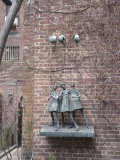





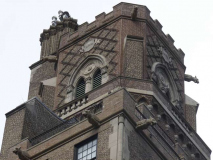














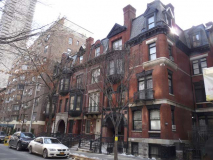










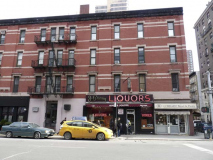






9 comments
This area still retains its German heritage with the Von Steuben Day Parade that’s held here every year in September.
Concerning: the two-story lengthy building with decorative urns that takes up most of the west side of the block between West 78th and 79th…. it appears that the upper floor may be residential, as there appears to be a balcony protruding…. any thoughts on that?
Not part of the two storey building. It’s part of the house next door along 78th street.
By the way, there is a 1984 book about named apartment buildings – LIVING IT UP: A GUIDE TO THE NAMED APARTMENT HOUSES OF NEW YORK, by Thomas Norton and Jerry Patterson. It lists the St. George in it, but no details behind the reason for the name.
The two avenues, Lexington and Madison, were laid out at the same time as the opening of the New York and Harlem Railroad on 4th Avenue in 1832. By 1934 the railroad was operating from Prince and Bowery to somewhere in Yorkville. Ten years later, the line was going from City Hall to White Plains. Adding those avenues created a lot of opportunity for extra storefronts and residential housing that would benefit from the presence of the railroad.
I meant “1834” not 1934. By 1934 the NYH had long disappeared and only the tracks from Grand Central to points north remained as part of New York Central.
The distance from 5th Av to 6th Av (about 1023′) is the same as that from 5th Av to Park/4th Av and from there to 3rd Av, and an additional avenue was planned between 5th and 6th Avs. around the same time as Lexington and Madison Avs, but was never built. There is, however, a 6-1/2 Av. pedestrian walk beginning at W. 51st St. – https://maps.google.com/maps?ll=40.76122,-73.981633&spn=0.000016,0.009645&t=m&z=17&layer=c&cbll=40.761277,-73.981765&panoid=U6IqY278s_KaQ1L0s7sGug&cbp=12,86.07,,1,-3.1
Bob
One reason there are more east-west blocks on the Upper East Side than on the West is that 3 long blocks on the west side of Fifth Avenue went into Central Park, which is all on the West Side. Otherwise the two sides would be equal.
Couple of additional comments from me, a neighborhood resident.
1. Re the balcony at 78th and Lexington. It is not part of the two-storey structure (which was originally a bank). It is part of the house next door along 78th Street.
2. Re the former Lascoff’s. It was taken over by the optician Warnbe Parker and they did keep the sign, just replacing the Lascoff name with their own. It may be landmarked.